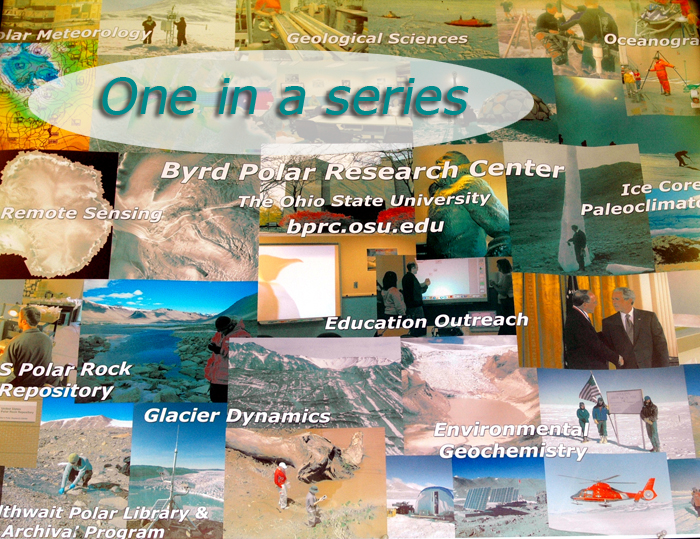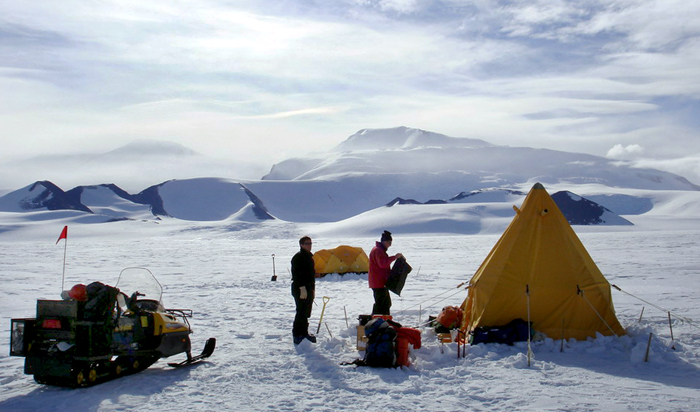|
The Great DyingScientists look for clues that climate change caused mass extinctionPosted August 15, 2008
About a quarter of a billion years ago, the most severe extinction event in the planet’s history wiped out just about every form of life on Earth.
Related Article
Upwards of 95 percent of the critters that swam, floated, drifted or hugged the ocean bottom died off. About 70 percent of everything on land also disappeared. Why?
That’s the big question that spurred Matthew Saltzman and colleagues to go to the Transantarctic Mountains of Antarctica during the 2007-08 summer field season. An associate professor at The Ohio State University’s School of Earth Sciences
“A lot of evidence points to global warming at the time, so the question then becomes, ‘What is it that caused the global warming?’” Saltzman said.
There are a number of theories on the P-T extinction. Could an impact from an asteroid have triggered the event, like the one that many scientists believe ended the domination of the dinosaurs 65 million years ago? Or did massive volcanic eruptions spew enough greenhouse gases into the atmosphere to warm the planet past a tipping point after the dust and aerosols from the eruption settled, which would initially cause the world to cool?
The answer could have implications for today’s world, as humans continue to crank up the thermostat, if it turns out global warming snuffed out life en masse on Earth.
Saltzman and three team members ventured into Antarctica’s backcountry to collect shale, sandstone, petrified wood, and other types of rock containing organic material that they could use to compare stable isotopes of carbon, which help scientists reconstruct past climate.
An important ratioScientists can measure the ratio between two isotopes of carbon, carbon-13 and carbon-12, in a rock sample. Each carbon-13 atom has an extra neutron in its nucleus, making it slightly heavier than carbon-12 atoms. Living organisms like plants prefer the isotopically lighter carbon-12. As a result, carbon-containing molecules become enriched in carbon-12, which turns up in the organic material entrenched in rocks.
The greenhouse gas methane can be even more enriched in carbon-12 than photosynthetically produced organic matter, Saltzman said.
Normally, the ratio between carbon-12 and carbon-13 is zero or one, but in certain times throughout history, such as during and after a great extinction, the ratio markedly increases or decreases. Scientists call the variation an “excursion” from the normal value of zero or one.
“Antarctica is one of the places that preserves, in terrestrial deposits, one of the most complete sequences through the extinction interval,” Saltzman explained. “Some of the most convincing evidence for a methane-induced [mass extinction] event comes from Antarctica, from carbon isotopic measurements of terrestrial organic matter. We were going there to explore some of the proposed ideas.”
In other words, some event released a large amount of methane into the atmosphere, enough to cause global temperatures to spike several degrees Celsius and alter the climate to the point that it pushed most life to extinction. Plants would have absorbed more carbon-12 compared to carbon-13, a sort of climatic fingerprint to this mass murder.
Heat sourcesWhat could send up so much isotopically light carbon into the atmosphere? Burning a vast coal deposit might have been a factor, Saltzman noted. “That’s what we’re doing today in our global warming scenario,” he explained. “The atmosphere is becoming isotopically lighter and lighter as we burn more and more of this organic material.”
Of course, humans weren’t around to light a pyre of coal 250 million years ago, though something like a strong series of continuous volcanic eruptions might have sent hot lava flows into coal-containing sediments, a conflagration that could have released carbon dioxide and methane in vast quantities.
Another theory that might explain the extraordinary ejection of methane, which is many times more powerful than carbon dioxide in warming the atmosphere, relies on methane hydrates. Methane hydrate is an ice-like substance that traps methane molecules in water. It forms under the intense pressure and cold in the ocean.
A drop in sea level or an increase in ocean temperature at the time of the P-T boundary might have set off this reservoir of methane, like a field of land mines waiting for a slight change in pressure to explode.
Whatever the source of the intense warming, the oceans may have become anoxic, stripped of oxygen, as the warmer upper layer closed like a lid on the colder layer below, cutting off the supply of oxygen, leading to the death of most marine life.
Back from the fieldGreg Retallack and his PhD student Evelyn Krull from the University of Oregon, published results in 2000 from one site in the Transantarctic Mountains that showed a strong excursion signal between carbon-12 and carbon-13.
“It shows some dramatic changes in the carbon-13 and carbon-12 ratio,” Saltzman said. “The magnitude of the changes is very remarkable, and difficult to explain with anything other than methane, if the data are in fact reproducible.”
The data came from a site called Graphite Peak. Saltzman and his team ventured to other places around the Shackleton Glacier in the mountains where his colleague David Elliot, also from OSU, published a paper in 2006 indicating that the Permian-Triassic boundary might be more complete and ideal for a comparative study.
The scientists camped in Scott polar tents, A-frame-shaped shelters that date back to the early days of Antarctic exploration, and drove skidoos from their campsite to valleys in the mountains, and then hiked across areas on foot. A Twin Otter flight crew also shuttled the scientists to more distant sites for several days.
“[The pilot] could land just about anywhere, it seemed to me,” Saltzman said. The team returned from the field with eight boxes of rock material, a total of about 200 kilograms. Saltzman said it would take the researchers several months to pulverize the rock and dissolve the minerals to get at the trace amount of organic matter they need for their analysis.
“Some time in the fall we should have a good amount of data that will lead us in one direction or another on this,” Saltzman said.
NSF-funded research in this story: Matt Saltzman and David Eliot, The Ohio State University, Award No. 0636824
|









